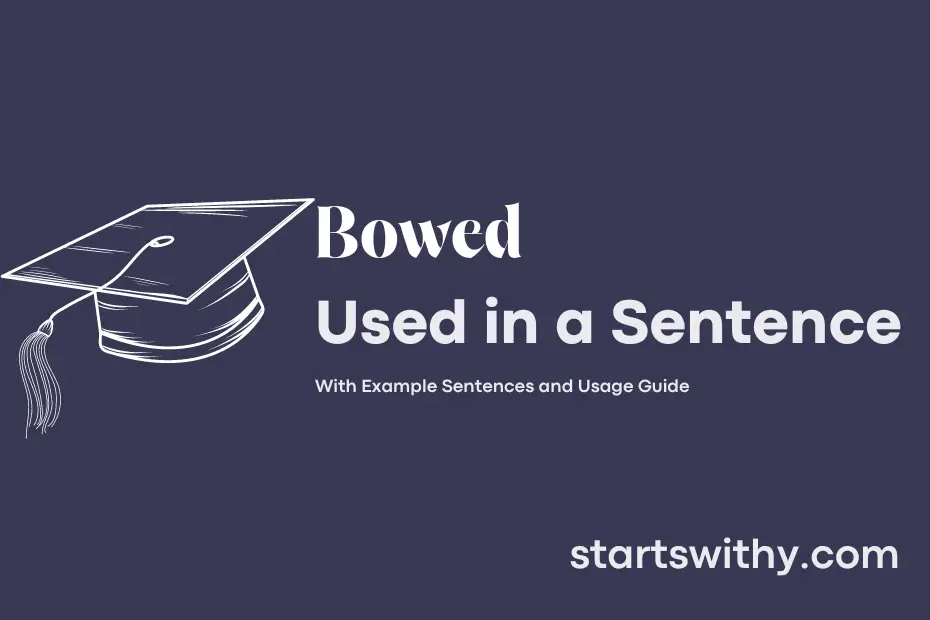Have you ever come across a sentence where someone bowed to another as a sign of respect or gratitude? In grammar and syntax, the word “bowed” is often used as a verb to describe the action of bending forward at the waist as a gesture of respect or submission.
When “bowed” is utilized in a sentence, it typically indicates a physical action or movement that conveys reverence, humility, or acknowledgment towards another person or entity. This word adds a layer of depth and emotion to the sentence, allowing the reader to visualize the act of bowing and understand its significance in the context provided.
7 Examples Of Bowed Used In a Sentence For Kids
- He bowed before the teacher to show respect.
- The little girl bowed as she greeted her grandparents.
- The dancer bowed gracefully after her performance.
- The puppet bowed as if it was saying thank you.
- The tree branches bowed in the wind during the storm.
- The magician bowed before beginning his magic show.
- The boy bowed his head to tie his shoelaces.
14 Sentences with Bowed Examples
- The professor bowed as a sign of respect before beginning the lecture.
- The students bowed their heads in prayer before the exam.
- During the cultural event, the performers bowed to the audience after their performance.
- The guest lecturer bowed to acknowledge the warm welcome extended by the college.
- The students bowed before touching the feet of their elderly teachers during Teachers’ Day celebrations.
- As a gesture of gratitude, the scholarship recipients bowed to the donors at the award ceremony.
- In martial arts class, the students bowed to their sensei before starting the training session.
- As a mark of humility, the winning team bowed to the opponents after a tough debate competition.
- The participants bowed to the judges before presenting their project at the science fair.
- The guest speaker bowed before starting the motivational speech at the career guidance workshop.
- During the yoga session, the students bowed in front of their instructor before starting the practice.
- As a token of appreciation, the student committee bowed to the college administration for their support during the annual fest.
- The debaters bowed to the audience at the end of the inter-college debate competition.
- With a sense of reverence, the students bowed before entering the temple on their college trip.
How To Use Bowed in Sentences?
Bowed is a verb that describes the act of bending the upper part of your body forward as a sign of respect, greeting, or acknowledgement. Here is a guide for beginners on how to use this word in a sentence:
-
To use bowed in a sentence, start by identifying the subject performing the action. For example, “She bowed politely before entering the room.”
-
Next, add the word bowed to the sentence to show the action taking place. For instance, “The man bowed low to show his reverence for the king.”
-
You can also use bowed to describe something that is curved or shaped like a bow. For example, “The tree branches bowed under the weight of the heavy snow.”
-
When writing or speaking, consider the context in which you are using the word bowed. Is it to show respect, acknowledge someone, or describe a physical shape?
-
Practice using bowed in various sentences to become more familiar with its meaning and usage.
Remember, using words in context will help you to better understand their meanings and improve your language skills. Keep practicing and incorporating bowed into your daily vocabulary to enhance your communication abilities.
Conclusion
In conclusion, the diverse examples of sentences with “bowed” illustrate a range of contexts in which the word can be used. From physically bending one’s head in respect or submission to the graceful arch of a bow in a performance, the word can convey different meanings depending on the context. “She bowed her head in shame” and “The ballerina gracefully bowed at the end of her performance” showcase the versatility of the word in describing gestures and movements. Overall, these sentences demonstrate how “bowed” can be employed to depict various actions and emotions, enriching the language with its nuanced implications and visual imagery.



